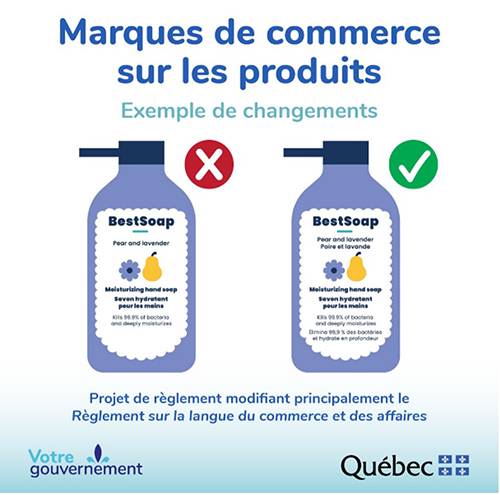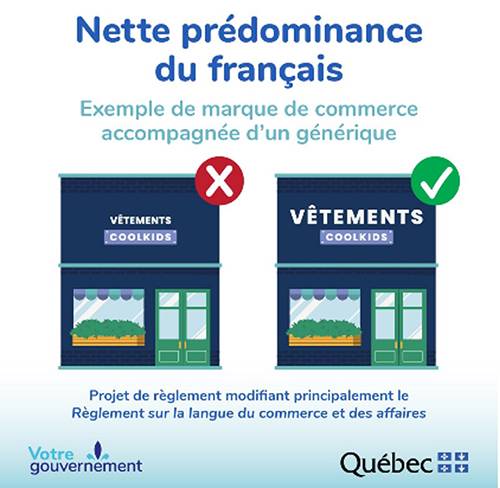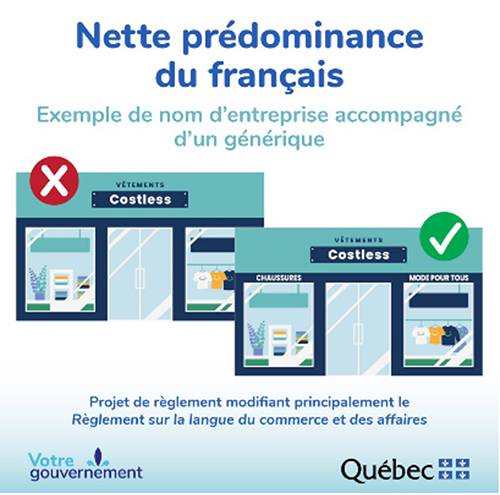Publication of the Regulation clarifying the obligations of Bill 96: Impacts on trademarks for products, advertising, and public signs and posters
by Chantal Desjardins, Isabelle Jomphe, Geneviève Bergeron
The Regulation1 specifying the new obligations of Bill 962 was published in the Gazette officielle du Québec on June 26, 2024. It modifies the current Regulation respecting the language of commerce and business.3 These changes were expected considering the questions raised by the passage of Bill 96 in June 2022, which required clarification. In this bulletin, we will discuss issues related to the use of trademarks in connection with products, commercial publications, public signs and posters, and commercial advertising.
Exception for recognized trademarks
Good news! The Regulation reintroduces the exception for ?recognized? trademarks,4 within the meaning of the Trademarks Act. Common law trademarks and trademarks registered with the Canadian Intellectual Property Office (?CIPO?) may be used without a French version, provided that no French version of the trademark appears in the Register.
By regulation, the government has extended the scope of the exception to trademarks. Under Bill 96 it was to apply only to CIPO-registered trademarks. It has been extended to also cover common law trademarks. With this amendment, the government has made the rules around trademarks more consistent, whether they are used in connection with products, commercial publications or public signs and posters.
It is still recommended to register your trademarks to protect your rights, but registration is no longer a condition for compliance with applicable regulations.
Obligation to translate generic and descriptive terms included in trademarks
The Charter of the French language5 (the ?Charter?) stipulates that any inscription on a product, its container or its wrapping must be in French, and that no inscription in another language may be given greater prominence than that in French or be available on more favourable terms.
The Regulation confirms that the term ?product? includes its container, packaging and any accompanying documents or objects.6
The Regulation also clarifies the scope of the obligation to translate descriptions and generic terms included in trademarks:
-
?Description? and ?generic term?: A description refers to one or more words describing the characteristics of a product, while a generic term describes the nature of a product, excluding the name of the enterprise and the name of the product as sold.7 Designations of origin and distinctive names of a cultural nature are not considered a description or a generic term.
In all likelihood, the reference to the ?name of the product as sold? refers to the product?s main trademark, as opposed to secondary trademarks which may also be used in conjunction with a product. The obligation to translate generic terms or descriptions contained in the trademark would not apply to the main trademarks under which the product is sold.
Thus, according to the example provided by the Quebec government, there would be no need to translate into French the descriptions or generic terms included in the main trademark BestSoap:

The Regulation specifies that the French translation of these generic terms or descriptions must appear in French on the product or on a medium permanently attached to the product.8 However, it does not provide a definition of ?a medium permanently attached to the product.? It will be interesting to see how practice develops in this area, and how the Office québécois de la langue française (OQLF) interprets this notion.
Keep in mind the Charter?s principle that no inscription in another language should be available on more favourable terms. Companies opting for the medium option will need to ensure not only the permanence of the medium, but also its availability, under conditions that are at least as favourable.
It should also be noted that the size of the French translation of generic terms and descriptions included in a trademark is not specifically addressed in the Regulation. However, the OQLF website specifies that no generic term or description in another language should take precedence over that appearing in French; the OQLF thus seems to apply the general rule contained in the Charter.9 This means that the French text must be at least equivalent in size and appearance to that in another language, so that the latter is not predominant.
-
?Transitional period?: The Regulation allows a two-year grace period to give businesses time to comply with the above requirements. Until June 1, 2027, any product that does not comply with these new requirements may continue to be distributed, retailed, leased, offered for sale or lease, or otherwise offered on the market, whether in return for payment or free of charge, provided (i) it was manufactured before June 1, 2025, and (ii) no corresponding French version of the recognized trademark has been registered in the Canadian trademark register by June 26, 2024.10
Although it will still be necessary to make every effort to comply with obligations, this measure ensures that existing non-compliant products can be liquidated.
Commercial publications
The Regulation makes no changes to the rules governing commercial publications, such as catalogues, brochures, folders, commercial directories and other similar publications. The exception applicable to ?recognized? trademarks, which had not been amended in Bill 96 or in the draft regulations, remains unchanged. Common law trademarks and trademarks registered with CIPO may be used without a French version, provided that no French version has been registered.
Contrary to what had been envisaged in the draft regulations, websites and social media are not expressly named as commercial publications whose French version must be available on terms that are at least as favourable as any version in another language. To date, the interpretation adopted and applied by the OQLF and the courts is that websites and social media are considered commercial publications and must therefore follow the same rules. Nevertheless, we will remain watchful to see if the lack of explicit reference in the Regulation to websites and social media is of any significance, and if the OQLF will consider changes to its approach to these two types of communication.
Advertising and public signs and posters
It is well known that the Charter requires public signs and posters and commercial advertising in Quebec to be in French. They may be both in French and in another language provided that French is markedly predominant.11
The ?recognized? trademark exception also applies to public signs and posters and commercial advertising. Thus, common law trademarks and CIPO-registered trademarks may be used without a French version, if there is no corresponding French version in the Canadian trademark register.12
For public signs and posters visible from outside premises, the rule of ?sufficient presence? of French gives way to that of the ?clear predominance? of French, when the trademark or business name is in a language other than French, in whole or in part.13
Public signage visible from outside premises includes not only the exterior of a building, but also premises inside a shopping centre.14 In such cases, a trademark or company name in a language other than French must be accompanied by a generic term, a description of the goods or services concerned, or a slogan, in French.15 This trademark or company name visible on a storefront or inside a shopping centre will be considered in the overall visual impact of the premises. For the same visual field, text written in French has much greater impact when (i) the French text occupies a space at least twice as large as that devoted to text in another language, and (ii) its legibility and permanent visibility are at least equivalent to that of text in another language.
Finally, as concerns digital signage with alternating French and non-French text, the French text is considered to have a much greater visual impact when it is visible for at least twice as long as the non-French text.16
Note that there is no grace period for public signs and posters. Companies therefore have until June 1, 2025, to comply with the new rules.
The examples below, from the Quebec government, illustrate the application of these rules:



Here is a summary of the main changes to the Charter and the Regulation that will come into effect on June 1, 2025:
|
Products
(labels, containers, packaging, or any accompanying document or object)
|
- A ?recognized? trademark (registered or used) may be used in a language other than French, unless a corresponding French version is on the Canadian trademark register.
- Any description or generic term included in a trademark must appear in French, excluding the name of the company or the name of the product as sold (and other specific exceptions); on the OQLF website, it is stated that no generic term or description in another language may take precedence over that appearing in French.
- The French translation of these generic terms or descriptions must appear in French on the product or on a medium permanently attached to the product.
- A grace period until June 1, 2025, is granted for any product that does not comply with these new requirements; such a product may continue to be distributed, retailed, leased, offered for sale or lease, or otherwise offered on the market, whether in return for payment or free of charge, provided (i) it was manufactured before June 1, 2025, and (ii) no corresponding French version of the recognized trademark has been registered in the Canadian trademark register by June 26, 2024.
|
|
Commercial publications
(catalogues, brochures, folders, commercial directories)
|
- No change: A ?recognized? trademark within the meaning of the Trademarks Act (registered or used) may be used in a language other than French, unless a French version has been registered.
- It is expected that the rules governing commercial publications will apply to websites and social media, in line with the current interpretation of the OQLF and the courts.
|
|
Public signs and posters
|
- A ?recognized? trademark within the meaning of the Trademarks Act (registered or used) may be used in a language other than French, unless a corresponding French version is on the Canadian trademark register.
- In public signs and posters visible from outside premises, including inside shopping malls, when a trademark or commercial name is in a language other than French, even in part, French must be clearly predominant, taking into account the space allotted to the trademark or company name.
- The trademark or company name must be accompanied by French terms, in particular a generic term, a description of the products or services, or a slogan.
- For the same visual space, the space allotted to French text must be at least twice as large as that devoted to text in another language, and its legibility and permanent visibility must be at least equivalent to that of text in another language.
|
To learn more about this topic or for any questions concerning the Charter of the French language and its regulations, please contact our professionals or consult our previous publications!
- Regulation to amend mainly the Regulation respecting the language of commerce and business, Gazette officielle du Québec, (the "Regulation").
- An Act respecting French, the official and common language of Québec, SQ, 2022, c. 14 (?Bill 96?).
- Regulation respecting the language of commerce and business, CQLR, c. C-11, r. 9.
- Regulation, supra, note 1, s. 2 (7.1) and s. 4 (25.1).
- Charter of the French language, CQLR, c. C-11, s. 51
- Regulation, supra, note 1, s. 6 (27.1).
- Regulation, supra, note 1, s. 6 (27.2).
- Regulation, supra, note 1, s. 2 (7.1).
- Charter, supra, note 5, s. 51.
- Regulation, supra, note 1, s. 7. However, the grace period has been extended to December 31, 2025, for products covered by the new labelling standards set out in the Regulations Amending the Food and Drug Regulations (Nutrition Symbols, Other Labelling Provisions, Vitamin D and Hydrogenated Fats or Oils) (SOR/2022-168) or the Regulations Amending the Food and Drug Regulations and the Cannabis Regulations (Supplemented Foods) (SOR/2022-169).
- Charter, supra, note 5, s. 58.
- Regulation, supra, note 1, s. 4 (25.1).
- Charter, supra, note 5, s. 58.1 and Regulation, supra, note 1, s. 4 (s. 25.1).
- Regulation, supra, note 1, s. 6 (27.5).
- Regulation, supra, note 1, s. 6 (27.7).
- Regulation, supra, note 1, s. 6 (27.6).